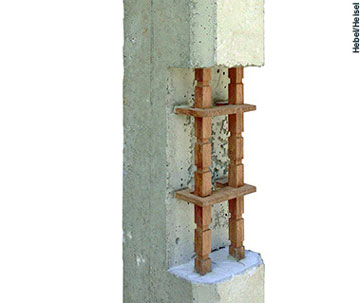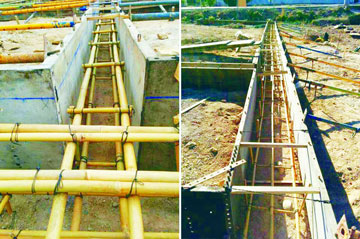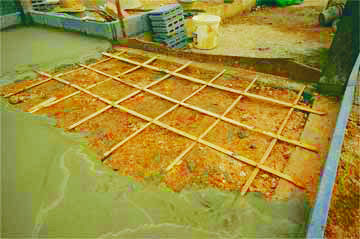Bamboo as Reinforcement
Search for alternative construction materials for sustainable engineering is advancing at a rapid pace keeping in mind the harmful impact of high embodied carbon in construction materials. Research on the use of a bamboo as a composite material in place of steel to strengthen concrete is producing positive results and the built environment is looking forward for a material that is environmentally safe.
 |
As per the study made by Catherine A. Cardno (and presented in American Society of Civil Engineers), very few developing countries have the resources to produce their own steel, and without this material tall buildings and urban development are all but impossible. But what if there were a local, renewable material that could be used instead of steel in reinforced-concrete buildings? And what if that substitute could be manufactured easily? These questions have motivated Dirk Hebel, an assistant professor of architecture and construction at the Future Cities Laboratory, in Singapore, to investigate a bamboo fiber composite as a possible substitute for steel reinforcement in concrete. The Future Cities Laboratory is a research arm of ETH (Eidgenössische Technische Hochschule) Zürich, in Switzerland, and is the first program under the newly formed Singapore-ETH Centre for Global Environmental Sustainability, which conducts multidisciplinary research to foster urbanization that conforms to the principles of sustainable development. If the tests on the bamboo composite are successful, developing countries will be able to manufacture and build their own urban centers without costly foreign steel imports, according to Hebel, who wrote in response to written questions posed by Civil Engineering online.
While the use of bamboo for construction extends back centuries, research that began in the 20th century on using it to reinforce concrete has been disappointing, Hebel said. Once embedded in concrete, natural, untreated bamboo absorbs water from the concrete mix and swells and shrinks in cycles. It is also susceptible to fungal growth. These processes cause the concrete to crack and the bamboo to debond from the concrete, rendering the concrete useless from a construction standpoint.
Processed Bamboo
Hebel's current tests use a material comprising naturally processed bamboo and an adhesive. Early tests have been positive with respect to both tensile strength and durability, he said.
To create the composite that is currently being tested by his team, fiber strands from the upper, middle, and lower sections of a five-year-old bamboo plant from China are bound together with a water-based resin that is low in volatile organic compounds. The harvested fiber strands are carbonized to minimize sugar content and then dried to minimize water content. After being mixed with the adhesive, the strands are pressed into a mold to form the desired shapes and thicknesses. Both hot and cold presses are being tested.
 |
The bamboo composite is approximately 80 percent bamboo and 20 percent adhesive and boasts a density of as much as 1.3 g/cm 3 , which is approximately three times higher than that of raw bamboo, according to written material provided by Hebel. This bamboo composite is water resistant, does not swell, and is durable, according to Hebel. Because it can be pressed into any shape and has good tensile strength, Hebel and his team believe that the composite will produce a reinforced concrete that will not be susceptible to the cracking and damage that occur when raw bamboo is used to replace steel reinforcement. Early tests completed on a laboratory scale confirm that hypothesis, he said.
"We are very much interested in fully controlling the properties of the new material-meaning the ability to change its thermal expansion, making it durable, and enhancing its fire resistance," Hebel said. These are important qualities for having the material certified by local standardization organizations and getting it out into the construction market, he explained. "In the concrete industry, we are breaking new ground," he said, but he also noted that the combination of steel and concrete is so well known and so widely used that it will be difficult to change the minds and habits of practitioners in the design and construction industry. His goal is to start with niche markets, for example, applications in which a noncorrosive reinforcement is needed.
 |
The bamboo composite material may also lend itself to other uses. These include such sports equipment as skis and rackets, and the material may prove useful in producing parts for the automobile and aerospace industries. "We want to show and to test that our material has a variety of application fields," Hebel said. And with each new application, he added, "durability is the most critical thing to guarantee."
But it is in urban construction that Hebel sees the most promise. He and his team view the replacement of steel with bamboo fiber composites as having the potential to jump-start a new age of industrialization in certain developing countries, for cities would then be able to produce their own construction materials. In the past, when the materials used for construction proved toxic or dangerous, the production of those materials had to be moved to other areas. "To reintroduce production into cities as part of a complex social and cultural lifestyle, it requires that this production-and the products themselves-do not harm our health or environment," Hebel said. "Renewable and 'green' materials like the one we are researching, which do not require a 'smoke industry,' but rather a low-tech approach, could be the game-changers whereby small and middle-sized companies can operate as part of an urban system."
 |
Under such a system the economic benefits flowing from the production of materials would remain local as well, he added. "Let's look at cities in Africa-they are highly productive, but what happens more and more is that the [process] of creating houses is outsourced to aid organizations in Europe, the United States, or China," he explained. "With that, foreign architects plan houses with foreign materials, [and] almost no jobs and no industry are created inside the cities or countries."
The use of a bamboo composite in construction to replace steel would enable developing countries to become more self-reliant in design and production, thereby boosting their economic growth. "Wherever bamboo is growing, this process could work out," Hebel explained. His team's research has shown that many developing areas that rely on imported steel, areas in, for example, Africa, Latin America, and Asia, are also regions in which bamboo grows naturally.
"The next big hurdle is to leave the laboratory of the university and to build pilots where we can demonstrate the possibilities of the material," Hebel added. He hopes to have the financing in order so that the first pilot tests will be ready within two years. Until that time, the lab will continue its research and will investigate how the bamboo fiber composite interacts with other materials.
Reference: Bamboo Reinforcement Could Help Developing Cities, By Catherine A. Cardno, Ph.D